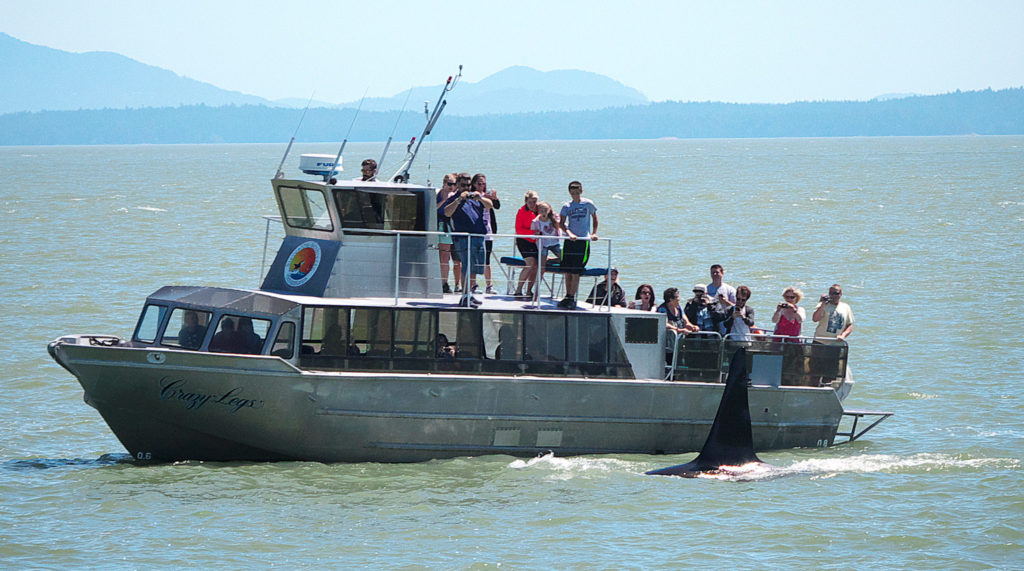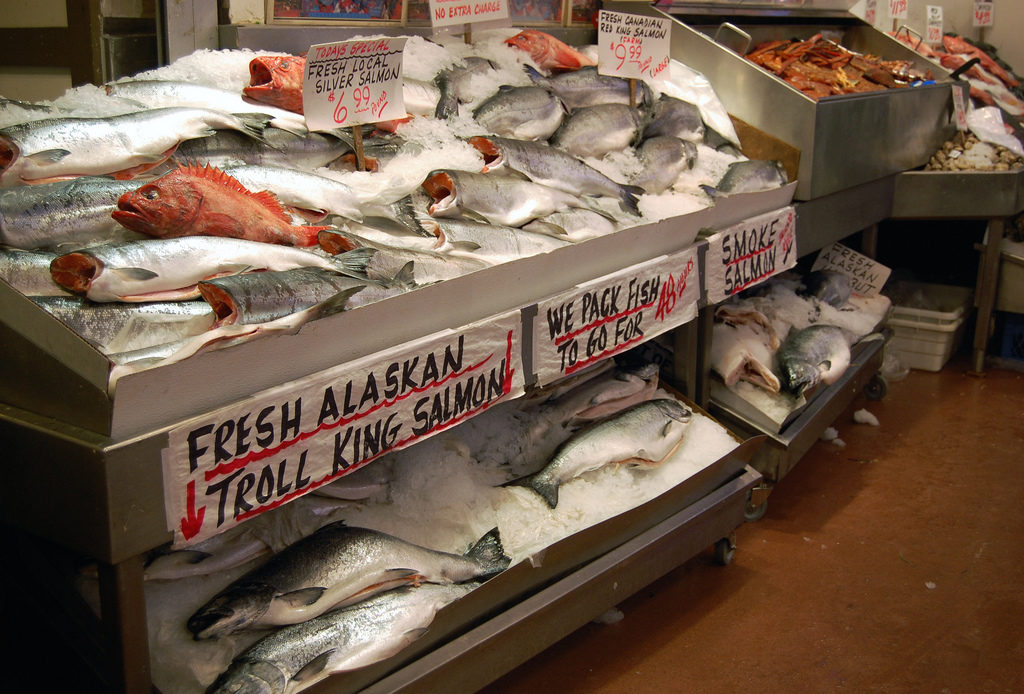Washington State Governor Inslee’s “Southern Resident Killer Whale (SRKWs) Draft Task Force Report” was released on October 1st. The report addresses the numerous actions that governments and businesses have failed to implement over the years to protect the endangered SRKWs. Will both the United States and Canadian governments call for immediate actions to protect orcas? It’s a matter of life or extinction!
Since 1993, the Vancouver, Canada based ecology organization, Lifeforce, has conducted the Lifewatch Boater Awareness program to monitor boat traffic and its impact on endangered orcas. Over the years, Lifeforce has made several recommendations, such as 200-400 yard boat distances, No Go Zones, 30 minute limits with limited boats, orca days off, limited day viewing only, “How’s My Driving?” boat posters giving customers information to report if a company is in violation, and no tours in limited visibility conditions such as fog. The Pacific Whale Watch Association opposed all changes. They still continue to claim that they are not at fault and that the orcas just need more salmon.
Even these increased protection measures will not solve all the problems. For example, orcas can detect specific boats, so when they even hear boats approaching that have harassed them they will get defensive, which causes stress and interferes with behaviors such as foraging. If proper measures were taken during the past 25 years, this would not be the last hope for orcas. Due to the excessive number of industry vessels and other boat traffic, including research boats, fishing vessels, and private boats, more immediate action is now needed. These necessary actions include:

A whalewatching vessel comes extremely close to an orca in British Columbia, Canada. Image credit Rob Hurson, CC BY-SA 3.0.
1. Stop Boat Traffic!
Implement a moratorium on whale watching the SRKWs, whose family numbers only 74 individuals.
There must also be at least seasonal restrictions (not all year whale watching) for the other ecotypes of orcas, such as Transients, Northern Resident Killer Whales (NRKW) and Offshores. There are approximately 300 members in each of these ecotypes, and they are also at risk by the same boat traffic issues.
Whale watch industry companies continue to get way too close to orcas (with many excuses, such as “they came over to say ‘Hi,'” or “they changed direction”). This especially happens when whale watching companies are not being monitored. There are over 100 companies in Southern British Columbia and Northwest Washington. Lifeforce has reported countless violations and continues to do so. The Washington Department of Fish and Wildlife has laid fines and given notices based on Lifeforce’s violation reports.
No Go Zones must also be designated for highly congested vessel areas where regulated 200-400 yard boundaries cannot be met. One such area in Canada would be Active Pass.

Salmon and other marine animals on sale at the Pike Place Market in Seattle, Washington. Image credit Jpellgen, CC BY-SA 3.0.
2. Stop Starvation!
Once again sea lions and seals are taking most of the blame for depleted salmon. Who else do you kill besides the seals and sea lions? Do you kill all the other fish eaters such as herons, eagles, bears, dolphins, porpoises, and whales? Killing wild predators will not save the salmon!
Who is really responsible for devastating the fragile ocean food chain? Is it humans or wildlife? History proves that it was humans who have plundered and devastated more than their share. There must be immediate fishing moratoriums on many species to mend the broken ocean food chain.
Humans have the choice to go to grocery stores, while wildlife do not have such plentiful food choices. With a growing human population and increasingly depleted wild fish stocks, people must seek alternatives to eating wild fish, such as transitioning to a plant-based diet.
In order to save the orcas, emergency actions must be implemented immediately. This must include five year moratoriums on commercial, sport and First Nation fishing.

A storm drain, one of the routes through which pollutants enter waterways. Image credit Chesapeake Bay Program, CC BY-SA 3.0.
3. Stop Pollution!
Salmon and other fish habitats have been polluted by human development, animal excrement from factory farming, slaughterhouse waste, fish farming, treating the oceans as a garbage dump, dumping human sewage into waterways and oceans, oil “spills” and much, much more. Ocean pollution must be addressed in order to restore the balance of marine ecosystems.
4. Prioritize Education!
Lifeforce has previously recommended to the Canadian Department of Fisheries and Oceans that Marine Mammal Regulations should be mailed to marinas, tourism hotels, boat dealers, boat insurance companies, and other associated marine industries. The public must be better educated!
It is also important that all whale watch companies have “How’s My Driving?” posters for customers and others to report any concerns and violations while on tours. This would help with the present lack of government enforcement.
Training by marine associated businesses and associations must include Marine Mammal Regulations/Guidelines and how to properly operate boats for the safety of both orcas and people.
5. Call Them! Don’t Bomb Them!
Previously Lifeforce’s research into the use of passive orca playbacks was not a considered by the United States National Oceanic and Atmospheric Administration (NOAA) as a priority response to oil spills. Instead, they list seal bombs, helicopters and banging pipes called “oikomi” by Japanese dolphin herders.
At a NOAA meeting in 2007 held to discuss oil spill protection for orcas, a former aquarium capturer said that the use of seal bombs, which are small explosive devices commonly used by fishermen to drive seals away, is likely to cause deafness in orcas. He advised not to use seal bombs for this reason. In addition, since dolphins are highly sensitive to sound, the “oikomi” banging of pipes is highly stressful and dolphins have gone into shock and beached as a result of its use.
Now the use of orca playbacks has been demonstrated to be highly effective for calling orcas out of dangerous situations. There are now four examples proving that it gets the desired response. First there was an accidental playback. Secondly, a pod changed direction while Lifeforce was testing our new playback equipment. Thirdly, Canada’s DFO intentionally attracted a younger orca. And finally, the recent high profile case intentionally attracting T073B out of Comox Harbor. No further research is needed, as that may only habituate some orcas, making the technique ineffective.

A NOAA research vessel observes a SRKW. Image credit NOAA, CC BY-SA 3.0.
6. Stop Invasive Experiments that Led to the Death of a SRKW!
Sentient, endangered orca families must not continue to be treated as research tools. They are being studied to death and it must stop! For example, a dart tracker caused an infection that led to the death of an endangered SRKW. This was unnecessary, as a massive hydrophone system covering the oceans already exists and can be used to track orca movement. Such darts and skin biopsies can open pathways for infection, especially in polluted waters.
Please sign this change.org petition calling for an emergency order to protect the Southern Resident Killer Whales!
Featured image: Orca L82 breaching. Image credit Miles Ritter, CC BY-SA 3.0.





